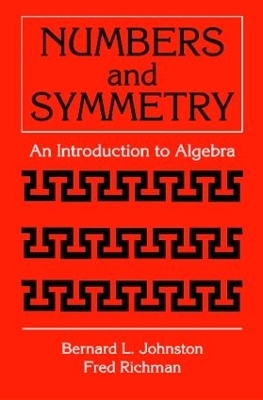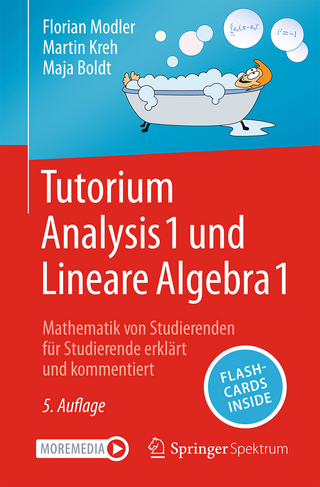
Numbers and Symmetry
Crc Press Inc (Verlag)
978-0-8493-0301-2 (ISBN)
This textbook presents modern algebra from the ground up using numbers and symmetry. The idea of a ring and of a field are introduced in the context of concrete number systems. Groups arise from considering transformations of simple geometric objects. The analysis of symmetry provides the student with a visual introduction to the central algebraic notion of isomorphism.
Designed for a typical one-semester undergraduate course in modern algebra, it provides a gentle introduction to the subject by allowing students to see the ideas at work in accessible examples, rather than plunging them immediately into a sea of formalism. The student is involved at once with interesting algebraic structures, such as the Gaussian integers and the various rings of integers modulo n, and is encouraged to take the time to explore and become familiar with those structures.
In terms of classical algebraic structures, the text divides roughly into three parts:
Department of Mathematical Sciences Florida Atlantic University Boca Raton, Florida. Department of Mathematical Sciences Florida Atlantic University Boca Raton, Florida.
1 New numbers -- 1.1 A planeful of integers, Z[i] -- 1.2 Circular numbers, Zn -- 1.3 More integers on the number line, Z [V] -- 1.4 Notes -- 2 The division algorithm -- 2.1 Rational integers -- 2.2 Norms -- 2.2.1 Gaussian integers -- 2.2.2 Z[V2] -- 2.3 Gaussian numbers -- 2.4 Q (V2) -- 2.5 Polynomials -- 2.6 Notes -- 3 The Euclidean algorithm -- 3.1 Bezout’s equation -- 3.2 Relatively prime numbers -- 3.3 Gaussian integers -- 3.4 Notes. -- 4 Units -- 4.1 Elementary properties -- 4.2 Bezout’s equation -- 4.2.1 Casting out nines -- 4.3 Wilson’s theorem -- 4.4 Orders of elements: Fermat and Euler -- 4.5 Quadratic residues -- 4.6 Z[/ /2) -- 4.7 Notes -- 5 Primes -- 5.1 Prime numbers -- 5.2 Gaussian primes -- 5.3 Z [s /2] -- 5.4 Unique factorization into primes. -- 5.5 Zn. -- 5.6 Notes -- 6 Symmetries -- 6.1 Symmetries of figures in the plane -- 6.2 Groups -- 6.2.1 Permutation groups -- 6.2.2 Dihedral groups -- 6.3 The cycle structure of a permutation -- 6.4 Cyclic groups -- 6.5 The alternating groups -- 6.5.1 Even and odd permutations -- 6.5.2 The sign of a permutation -- 6.6 Notes -- 7 Matrices -- 7.1 Symmetries and coordinates -- 7.2 Two-by-two matrices -- 7.3 The ring of matrices -- 7.4 Units -- 7.5 Complex numbers and quaternions -- 7.6 Notes -- 8 Groups -- 8.1 Abstract groups -- 8.2 Subgroups and cosets -- 8.3 Isomorphism -- 8.4 The group of units of a finite field -- 8.5 Products of groups -- 8.6 The Euclidean groups E(l), E(2) and E(3) -- 8.7 Notes -- 9 Wallpaper patterns -- 9.1 One-dimensional patterns -- 9.2 Plane lattices -- 9.3 Frieze patterns -- 9.4 Space groups -- 9.5 The 17 plane groups -- 9.6 Notes -- 10 Fields -- 10.1 Polynomials over a field -- 10.2 Kronecker’s construction of simple field extensions -- 10.2.1 A four-element field, Kron(Z2, X2 + X + 1) -- 10.2.2 A sixteen-element field, Kron(Z2, X4 -f X + 1) -- 10.3 Finite fields -- 10.4 Notes -- 11 Linear algebra -- 11.1 Vector spaces -- 11.2 Matrices -- 11.3 Row space and echelon form -- 11.4 Inverses and elementary matrices -- 11.5 Determinants -- 11.6 Notes -- 12 Error-correcting codes -- 12.1 Coding for redundancy -- 12.2 Linear codes -- 12.2.1 A Hamming code -- 12.3 Parity-check matrices -- 12.4 Cyclic codes -- 12.5 BCH codes -- 12.5.1 A two-error-correcting code -- 12.5.2 Designer codes -- 12.6 CDs -- 12.7 Notes -- 13 Appendix: Induction -- 13.1 Formulating the n-th statement -- 13.2 The domino theory: iteration. -- 13.3 Formulating the induction statement -- 13.3.1 Summary of steps -- 13.4 Squares -- 13.5 Templates -- 13.6 Recursion -- 13.7 Notes -- 14 Appendix: The usual rules -- 14.1 Rings -- 14.2 Notes -- Index.
| Erscheint lt. Verlag | 7.1.1997 |
|---|---|
| Verlagsort | Bosa Roca |
| Sprache | englisch |
| Maße | 156 x 234 mm |
| Gewicht | 500 g |
| Einbandart | Paperback |
| Themenwelt | Mathematik / Informatik ► Mathematik ► Algebra |
| ISBN-10 | 0-8493-0301-X / 084930301X |
| ISBN-13 | 978-0-8493-0301-2 / 9780849303012 |
| Zustand | Neuware |
| Informationen gemäß Produktsicherheitsverordnung (GPSR) | |
| Haben Sie eine Frage zum Produkt? |
aus dem Bereich


